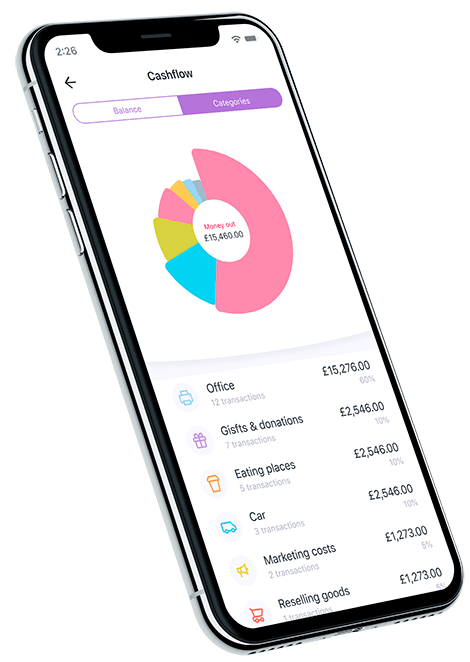Starting your business: The importance of cash flow

Maintaining a healthy cash flow is key to business success.
Whether you’re starting a new business or you’re already established, you need to keep the cash flowing. At the start of a business journey, most people see the threat posed by a lack of income, but that’s only one part of cash flow. And a failure to keep on top of this is behind many startup disappointments.
Maintaining a positive cash flow in both the short and long term is a surefire way to make sure your business doesn’t run out of money. That’s not easy - even when times are good - but it is essential.
The best way to stay on top of your cash flow is to track money in and out of your business. The Amaiz app has one tool that can help you with this - capturing your income and expenses and visualising them in a real-time chart. But companies of all sizes should consider putting time into forecasts.
Cash Flow forecasts
Contrary to popular belief, a cash flow forecast isn’t just for large organisations with multi-million-pound turnover and an eye on acquisition. A business of any size will benefit from cash flow forecasts. It helps them plan ahead, navigate the unexpected, and achieve peace of mind.
A cash flow forecast estimates the money you expect your business to bring in and pay out over a specific time. Generally, working 12 months ahead does the trick. When you build a forecast, you’re essentially estimating the income your business will make from sales or services to customers, investments, or any tax-deductible payments (such as those you make to suppliers, staff, insurers or HMRC).
Reasons why cash flow forecasts work for small businesses
For a startup or small business owner busy running a company and concentrating on keeping new customers happy, forecasting can seem like an additional administrative burden. But they’re actually relatively easy to set up and keep running, and they could make all the difference if they help keep your business afloat.
A cash flow forecast helps you:
- See your future income and expenditure more clearly
- Track customer payments and chase overdue invoices.
- Plan for cash gaps. For example, if you know your expenses will be bigger than your income at a particular point, you can factor in an overdraft or money you’ve set aside.
- Understand your expenses so you can cut down or scale up to suit your circumstances.
Cash flow forecasts help you to make more precise, more confident decisions based on data rather than over-relying on gut feelings or risk losing control. You can, for example:
- Plan at what point you can afford to recruit more staff if your business is growing.
- Crystalise strategies to grow your business, such as cross-selling into other markets or making seasonal adjustments
- Maintain reserves - a buffer zone will help you get through the tougher times most companies go through.
- Identify and plan for future borrowing needs if cash dries up in specific periods - and remember, it’s easier to find funding when money isn’t tight
- Spot trends and respond with discounts and special offers at the right time
- Assess if you can afford high or infrequent costs - such as moving to physical office space if you work from home.
How to run a complete cash flow forecast
The simplest way to run a cash flow forecast is on a spreadsheet. There are lots of templates available online. Essentially, you will have to estimate your business’s future income and expenses. It should extend from your company’s current balance sheet, as visualised in the Amaiz app.
These are the two main components you need to produce a cash flow forecast:
Income Forecast
There are a few ways you can predict your business income:
- Short term
If you want to predict income for the next few months, the quickest way is to check your customer invoice due dates. From the date these are raised, you can estimate when they’ll turn into cash received to your account. - Long term
To forecast for, say, six months from now, you will have to dig deeper into your sales. Are you launching any new products in the next half year? Try to predict how many sales these might bring in. If you generate revenue from milestone payments for contracts, you can use these to estimate your income. - Previous years’ income
If you’ve been trading for a while, look back to see if you can identify any seasonal variations.
Expenses Forecast
There are a great many potential expenses a business should bear in mind. Some will be fixed, while others will depend on the sales you achieve.
Fixed Expenses
The best way to estimate your fixed costs for a future period is to look at expenses incurred in a previous month. Make a note of fixed costs such as rent, business rates, utility bills, employee salaries, employer’s NI, software subscriptions, mobile phone bills, professional fees such as solicitors and accountants fees. Most of these won’t vary too much, although they could change if you expand your business.
If you’re looking to recruit more staff, you’ll have to estimate the cost of that employment. Don’t forget that might also mean additional costs, as you rent more space or purchase more equipment for them (see capital expenditure below).
Variable expenses
These often depend on your sales levels. For example, if you are an online retailer importing goods from abroad to sell online in the UK, the more products you sell, the more postage and packaging costs you will incur. This will increase your variable costs.
Assuming you pay your suppliers for products on 30 days or other credit terms, the easiest way to estimate this cost in the short term is to look at the dates of invoices you’ve received from the supplier. To forecast for the longer term, look at your estimated future sales and calculate the cost of buying the goods needed to fulfil them.
Capital expenditure
If you’re planning to scale up your business soon, perhaps to grow your capacity and sales, you may need to spend money on new capital equipment. For example, if you are a hairdresser and want to increase the size of your salon, you will need to estimate the costs of buying new hairdressing equipment to fill it.
Finally, when you have estimated the cash coming into your business, and the cash paid out, don’t forget to calculate your net cash position. This tells you whether you have a positive or a negative balance at a particular time.
Grab a cash flow forecast template to get started
The government-backed Start Up Loans company has produced a cash flow forecast template as a handy starting point:
https://www.startuploans.co.uk/cash-flow-forecast-template/
If you prefer not to use Excel for your cash flow forecast, you can find alternative software online. Some will go a step further and link to accounting software or work out aspects of the forecast for you.
In Summary:
- Failure to manage cash flow is a significant cause behind the failure of startups
- Cash flow isn’t just income
- Challenging times hit every company
- It’s a lot easier to manage your cash flow in the good times
- Cash flow forecasting is easier than you think

Download now!
And you can open a business account with all the support you need in minutes.



